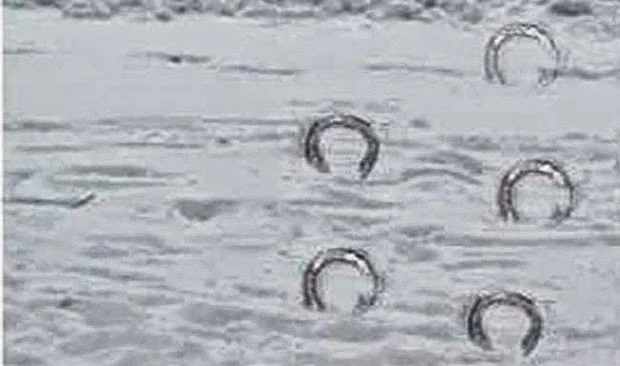In February of 1855, around the area of East and South Devon, England The Devil’s Footprints were found in the snow. These hoof-like prints covered approximately 60 to 100 miles, depending on who was telling the story. Just note this would be considered impossible for one person to accomplish in a day in the 19th century. These appeared to be cloven hooves, leading people to panic that Satan was among them. Each track measured at 4 inches long, 3 inches wide and approximately 8-16 inches apart in single file. Nearly 30 locations reported these mysterious footprints. They tracked over houses, frozen lakes and other obstacles. Some of the rooftop tracks travelled up to roofs, only to exit from pipes that were a mere 4 inches in diameter.
This extract from the article is quite interesting.
“It appears on Thursday night last, there was a very heavy snowfall in the neighbourhood of Exeter and the South of Devon. On the following morning the inhabitants of the above towns were surprised at discovering the footmarks of some strange and mysterious animal endowed with the power of ubiquity, as the footprints were to be seen in all kinds of unaccountable places – on the tops of houses and narrow walls, in gardens and court-yards, enclosed by high walls and pailings, as well in open fields.”
There is very little concrete evidence from which researchers can draw conclusions. Being the 19th century, video cameras, smartphones, and other recording devices were unknown to the populace. The only known documents associated with the Devil’s Tracks came to light in the Transactions of the Devonshire Association from 1950. These documents were found with the letters from Reverend G.M. Musgrove marked “not for publication” with drawings of the footprints.
The reverend wrote a letter to the Illustrated London News: “In the course of a few days a report was circulated that a couple of kangaroos escaped from a private menagerie (Mr. Fische’s, I believe) at Sidmouth.” It seems, though, nobody investigated if there were any escaped kangaroos, let alone how they could’ve crossed the estuary. Musgrove said he only came up with the story, to distract his parishioners’ concerns about a visit from the devil.
I found a very apt opportunity to mention the name of kangaroo, in allusion to the report then current. I certainly did not pin my faith to that version of the mystery … but the state of the public mind of the villagers … dreading to go out after sunset … under the conviction that this was the Devil’s work … rendered it very desirable that a turn should be given to such a degraded and vitiated notion … and I was thankful that a kangaroo … [served] to disperse ideas so derogatory
In 1994, Mike Dash collected the source material, compiling them for Fortean Studies in the paper “The Devil’s Hoofmarks: Source Material on the Great Devon Mystery of 1855″
According to Mike Dash, in his Fortean Studies article, he concludes there was no single source for these “hoof marks”. Some tracks were probably hoaxes, others were from “common quadrupeds” like donkeys and ponies, and others from wood mice . He admits these can not explain all the reported marks, and “the mystery remains”.
Geoffrey Household suggests the Devonport Dockyard may have accidentally released an experimental balloon, trailing mooring ropes which could’ve made the prints. The grandson of a man who worked at Devonport, Major Carter, claims the incident was quieted since some properties were damaged in the process. The shape of the prints might explain away with the balloon theory, but could a balloon have traveled in this random pattern without getting caught on something? Regarding the wood mice theory, when a mouse jumps, the motion and position of their limbs can leave a track resembling that of a hoofed animal. He wasn’t the first to present the idea, having been outlined in a March 1855 edition of The Illustrated London News.
In the summer of 1855, one ‘Professor Owen’ proposed the footprints were from a badger(!), arguing the animal was ‘the only plantigrade quadruped we have in this island’ and it ‘leaves a footprint larger than would be supposed from its size’. The number of footprints, he suggests ‘it is improbable that one badger only should have been awake and hungry’ and added that the animal was ‘a stealthy prowler and most active and enduring in search of food’.
Finally, the tracks might’ve been a case of mass hysteria where people were sharing stories out of hand, the news media picking up on the trends, making a mountain out of a molehill.



















0 comments